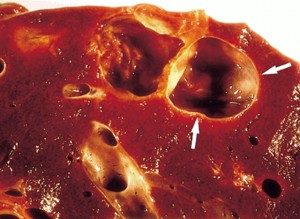
A growth on the liver can be simple, benign, and of no medical concern, or it can be a life-
Cysts
About one person in twenty will develop cysts on the liver at one time or another. A cyst is a thin-
In almost all cases, the cyst produces no symptoms and presents no danger. Occasionally, a liver cyst will generate pain or a sense of pressure in the upper abdomen. This can happen if bleeding into the cyst occurs. In that case, it can be worthwhile to drain the cyst through laparoscopic surgery, a procedure that requires an overnight hospital stay but is low-
Polycystic Liver Disease
Polycystic liver disease, or PLD, is actually not a disease in itself but a complication of polycystic kidney disease (PKD), which is a genetic disorder causing the kidneys to erupt in multiple cysts, leading inevitably to kidney failure. PLD occurs in a small percentage of PKD cases. Multiple cysts form on the liver, leading to general liver enlargement, abdominal swelling, and pain. Although extreme cases of PLD can severely reduce quality of life due to the swelling and discomfort, PLD does not cause liver failure, unlike the primary symptom of PKD, multiple cysts on the kidneys, which do cause renal failure. The only long-
Hemangioma
A hemangioma is a benign tumor. It is a swelling of the cells lining the blood vessels, producing a tangle of blood vessels that looks like a lumpy mass. In most cases, liver hemangioma produces no symptoms, presents no danger, and requires no treatment. There is no evidence that hemangiomas can become cancerous if untreated. In rare cases, a liver hemangioma may produce symptoms such as pain, a feeling of fullness after eating only a small amount of food, loss of appetite, nausea and vomiting. In cases where treatment is warranted, surgery either to remove the hemangioma or to cut off its blood supply is the usual treatment.
Liver Cancer
Of course, the most serious growth on the liver is a liver cancer. There are several different forms of primary liver cancer that can develop, some more virulent than others but all meriting aggressive treatment. Since the disease rarely produces early symptoms, it is usually detected (as are other forms of growth on the liver) through medical imaging such as an ultrasound or CT scan, frequently in the course of looking for something else.
Liver cancer can be treated surgically or through radiation therapy or chemotherapy. What treatment options are pursued depends to an extent on how early the illness was detected and whether it has spread to other parts of the body. It is also possible for cancer found in the liver not to be primary liver cancer but rather cancer that began elsewhere in the body and spread to the liver; this requires a different treatment option than primary liver cancer in many cases because the disease has already metastasized.